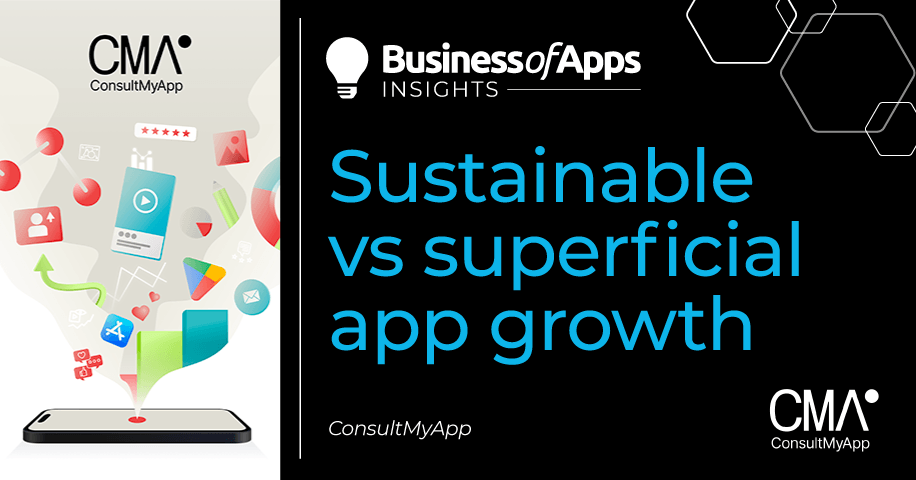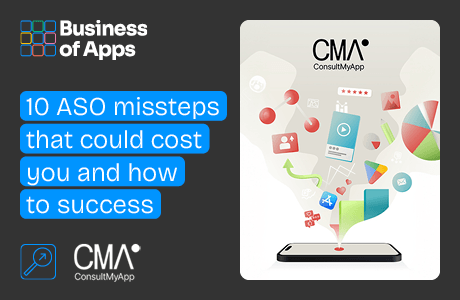Growth. A straightforward concept, right?
However, in recent times, as the tectonic plates of macroeconomics shift under our feet, our understanding of this term has wobbled. In this blog, we’ll talk about what true growth should look like for a mobile app and the tech industry as a whole and how to achieve it.
We’ll deconstruct the deceptive allure of vanity metrics, discuss profitability for mobile-based businesses, and ultimately, reveal how to take your app growth from superficial to sustainable.
What is superficial growth in mobile marketing?
Historically, in times of economic stability, money can be liberally invested. Until very recently, mobile tech brands have enjoyed a period of abundance.
Start-ups and businesses have gotten by without a solid understanding of how to grow sustainably while still managing to secure funding and expand—but how? Because the success, the ‘growth’ of those businesses (especially in their infancy) has quite often been mistakenly measured on what can be described as vanity metrics.
Recent times haven’t been quite as stable.
The catalyst of this mass tightening of purses for tech brands can be perhaps traced back to the Silicon Valley Bank (one of the biggest tech lenders) folding earlier this year. This was followed by tech-wide layoffs which have cost tens of thousands of workers their jobs, including within the biggest brands (Twitter, Google).
What are vanity metrics?
Vanity metrics are performance indicators that may impress on the surface—but here’s the snag—they don’t contribute directly to the success of said business.
They can also be described as second-level metrics, inflating the appearance of growth, but failing to provide any insight into a business’s overall health and success.
Some common examples of vanity metrics in mobile marketing include installs, downloads, monthly active users (MAUs), or daily active users (DAUs), to name a few. You’ll notice that generally most mobile marketing vanity metrics fall within acquisition. Gaining more and more users at (literally) any cost.
But gaining users is objectively positive, right? Well, unfortunately, things aren’t that simple in the mobile space. There are some major pitfalls to overemphasizing user acquisition.
Overemphasizing user acquisition at the expense of profitability
Having a vast user base is of little significance if said users do not interact with your app.
Picture this: You invest substantial resources into an expansive marketing campaign. It successfully draws in users from all walks of life, your downloads spike, you think—results! New users are pouring into your bucket.
But during the first week, most of those users (this can be up to 60%) can stop interacting with the app entirely. And after a while, your app becomes an icon simply crowding their home screen, the intent of the initial download completely lost.
And that’s the issue—that’s the hole—users trickle right out the bottom as you pour them in. Once the campaign ends, you find yourself back where you started, only with a large chunk of your budget depleted.
What is sustainable growth in mobile marketing?
Acquisition should never be the sole focus of your strategy. It’s not about just accumulating users; it’s about attracting the right users—those who will find real value in your app and keep coming back to it, time and time again.
User retention means keeping users engaged and interested in your app long after they’ve downloaded it. High user retention rates indicate a healthy app, one that offers value to its users and successfully meets their needs. This is the kind of growth that is sustainable and resilient.
But of course, you must first acquire users. These two processes are intertwined, forming two halves of the same growth strategy. You can’t prioritize engagement without first having users to engage with. Therefore, the focus must be placed on these two integral aspects of the growth strategy—user acquisition and user retention.
Sustainable growth
Source: ConsultMyApp
Paving the way towards profitability with your mobile app
Once you’ve established a robust framework for user acquisition and retention, the next milestone to strive for is profitability… This key objective takes your mobile app from being just a tool to a productive, revenue-generating asset.
There’s a direct correlation between user retention and profitability.
A loyal, engaged user base will be more likely to invest in in-app purchases, subscribe to premium features, or respond positively to in-app advertising and more (depending on your app), and transform it into a profitable venture.
Understanding the lifetime value (LTV) of your users is a crucial starting point. This metric reflects the total revenue you can expect from a single user throughout their lifecycle within your app. By improving user experience, enhancing app features, and regularly updating your content, you can increase the LTV—and voilà! Increase profitability.
Another important aspect of profitability is the optimization of your cost per acquisition (CPA). CPA is the total cost of acquiring a new valuable user, factoring in expenses such as marketing and advertising. Of course, a “valuable” user is subjective for each business, it may simply be a user that completes their first purchase, completes four levels of your game or successfully registers with you—defining that in itself is a crucial first step.
If the CPA is higher than the LTV, it means you’re spending more to acquire users than you’re earning from them – a surefire way to run your app into the ground. Therefore, continually working towards lowering the CPA while increasing the LTV will lead to a profitable balance.
Furthermore, establishing a strong monetization strategy is a must. Whether it’s freemium models, in-app purchases, advertising, or subscription models, the right monetization strategy will depend on the nature of your app and the preferences of your user base. It’s also important to iterate and test different strategies to see what yields the best results.
Achieving profitability with your mobile app isn’t merely about attracting and retaining users. It requires a thorough understanding of your revenue and expense metrics, alongside an effective monetization strategy. By focusing on these elements in tandem with user acquisition and retention, you can create a comprehensive growth strategy that drives long-term profitability.
Wrapping up: Cultivating sustainable mobile app growth and profitability
In the end, building a mobile app that not only grows but also thrives in the competitive marketplace is no walk in the park… It requires a strategic balance of user acquisition, retention, and a keen eye on the prize—profitability.
Remember that the journey of your app doesn’t end with user acquisition. In fact, it’s just the beginning. Fostering a relationship with your users, keeping them engaged, and constantly adding value to their experiences will ensure loyalty to your app. And this, in turn, leads to the sustainable growth that every mobile business should be striving towards.
Profitability, on the other hand, comes from a comprehensive understanding of your metrics, including lifetime value and cost per acquisition, and optimizing them for the best returns… It also relies on a well-planned monetization strategy tailored to fit your app and its users.
In essence, sustainable mobile app growth and profitability do not occur by accident. They are the result of a well-thought-out, data-driven strategy, that considers every single aspect of the user journey; that strategy must be underpinned by the right technology and a talented pool of experts to activate it.
If you are interested in establishing sustainable app growth with an award-winning App Marketing Agency – then don’t hesitate to get in touch with the ConsultMyApp team. You can email hello@consultmyapp.com or contact us directly here.












